Power and Joy
Power and Joy
Written By Darcy Dobell
Over the years I have had the pleasure of stopping in periodically at Whale Point on Gil Island for brief visits with Janie and Hermann. This June marked my first opportunity for an extended stay. It was a privilege to contribute, even in a small way, to the exceptional work carried out by the North Coast Cetacean Society, and an experience enriched by near-daily intimate encounters with Humpbacks and Orcas.
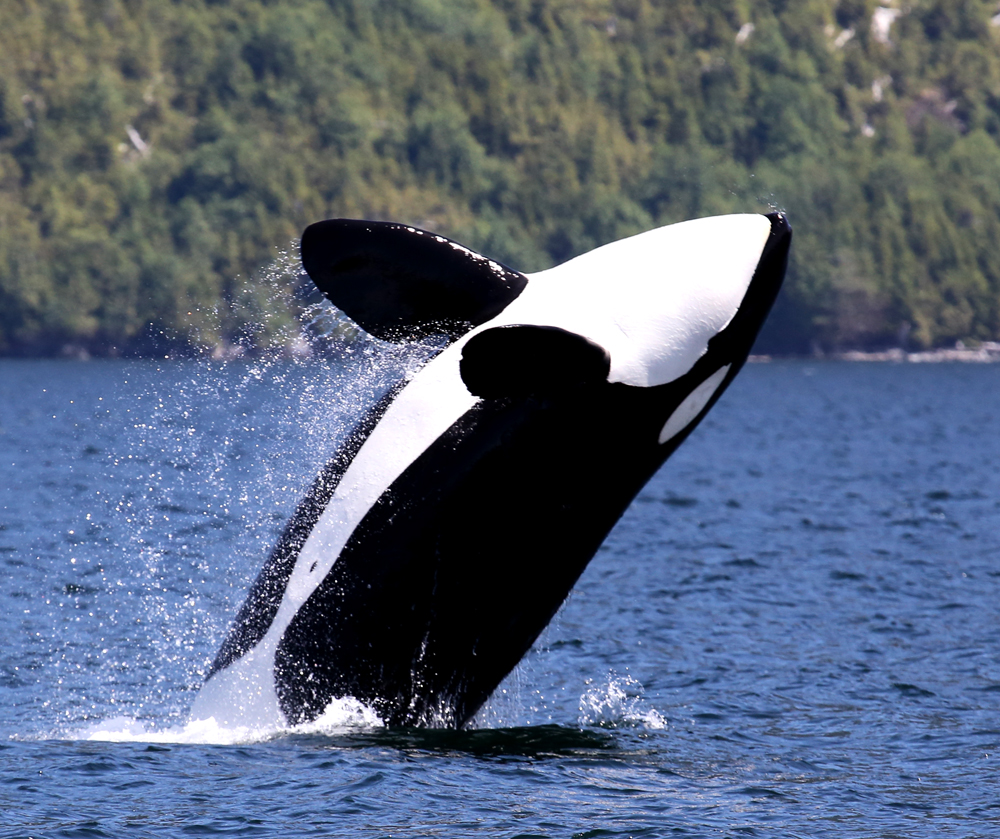
Some of the highlights included being escorted down Whale Channel by a focused but still playful gathering of some twenty transient Orcas; glancing up from snorkeling just in time to see the enormous mouth of a lunge-feeding Humpback surge through the water nearby; and being treated to several performances of acrobatics by the very small (relatively speaking) Humpback calf nicknamed “Champ,” whose flukes bear the scars from an Orca attack that clearly came close to ending this young calf’s life, but certainly did nothing to dampen its spirits.
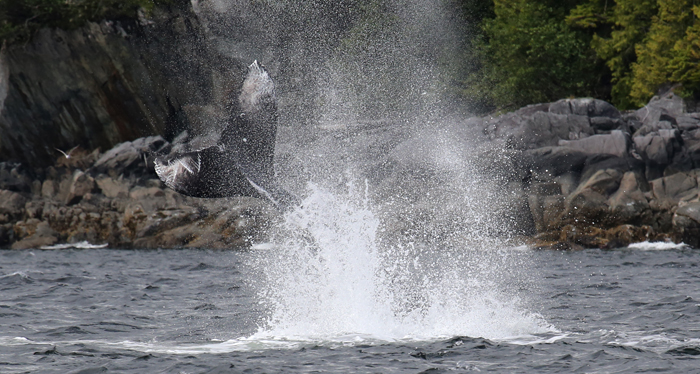
The most poignant moments, though, were those that followed the announcement of Canada’s approval of the proposed Enbridge oil pipeline and tanker route. From Cetacealab’s Caamano Sound outpost, little more than a coffeepot and a telescope cantilevered over some of the most crucial whale habitat on the coast of North America, I listened to the news ripple over the VHF radio (still the primary means of communication along the outer reaches of the North Coast). Word travelled in the understated and economical language of mariners: Roger that. Ok thanks. Did you copy? Copied, yep.

We always knew it would come to this. Yet it is still disappointing, even shocking, to hear an official approval. The short-sightedness of a poorly-planned project that would undo one of our continent’s last great wild places, and one of the world’s rarest, richest, and most spectacular ecosystems – along with the diverse economies and cultures that depend on it – is no less appalling for its predictability.

While the immediate news is discouraging, however, the longer-term outlook is anything but. This pipeline was always going to be approved, but it will never be built. In the wake of the announcement there is very palpable anger and a few tears, but nothing that remotely approaches resignation or despair. To say that oil tankers will never cross Caamano Sound is not to suggest that everyone can relax, but rather to acknowledge the certainty that nobody will.

The clipped exchange over the VHF belies a deep, fierce, and unrelentingly positive determination uniting communities, cultures, sectors, and generations up and down the coast and across the province. The overriding impression is one of steadfast power fuelled by a profoundly joyful connection to place. The image I’m taking with me is this: Champ leaping clear of the water in breach after breach, landing again and again in exuberant full-body splash, a triumph of resilience and life in this extraordinary place.
To Be Whaled
The follwoing Blog was written by Kim Ly who helped operate our remote outcamp in Caamano Sound. Her words flow so well and truly capture why so many of us are inspired by the presence of a whale.
To Be Whaled
Two months on the North Coast seem to have sailed by with these strong northwesterly winds blowing the day by to greet a star filled sky. Peppered throughout my reflections of this summer so far are several truly stirring whale encounters – Bear, the white-fluked humpback that greeted the Picard’s and I as we first pulled into Whale Point; the matriarch orca A30, who so curiously rushed towards Stan, Sophie and I on board the Hawk Bay zodiac; beautiful D13 (orca) who’s interest in our land-based research slowed her travels through the kelp beyond the cabin before joining the rest of her family; or Robust, the young humpback whale who decided the Elemiah and it’s passengers were worthy of her graceful dance.
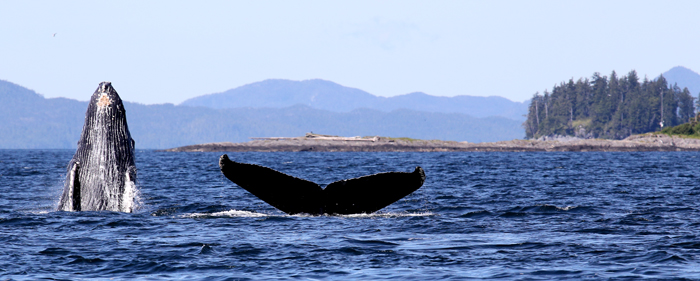
I can say with certainty that anyone who’s encountered a whale here, whether at Whale Point, the Wall, onboard the Elemiah, or otherwise, knows that there is a deeper meaning to the word “whale” than the Oxford English Dictionary’s very dry “a very large marine mammal with a streamlined hairless body, a horizontal tail fin, and a blowhole on top of the head for breathing.”
It would seem that a proper adjective is in order. Perhaps it would go something like this:
Whaled:
A psychological state following an encounter with a cetacean during which you are made aware of their own awareness – that as much as you are watching them, they are watching you. A concoction of awe, giddy amazement, humbleness, and inspiration with a small pinch of sorrow. Tears often ensue: Upon their return, they were thoroughly whaled.

It could be used to described how one feels about of the enormity of a humpback whale as she glides under the hull of the boat, with pectoral fins extended as if cradling its two-legged passengers. Or the glow of her belly as she gracefully lifts her fluke, with utmost control and awareness mere feet from your own body. It might capture the feeling of being a guest in her waters – the shift that is felt when your eyes meet hers as she lifts her head with time stilling grace from her watery medium to yours. It resonates with the meeting of two worlds in a confused yet compassionate understanding.
A state of whale-ment will deepen yet another degree as you realize that she, her own island of barnacled ecosystems, has become the vessel of several of our own hopes and aspirations. Live with curiosity and grace. Take only what is needed and give all you can. Foster life and inspire awe.
With a final dive, she’ll spread her wisdom elsewhere, leaving in her wake a final footprint upon the sea’s ever changing surface.
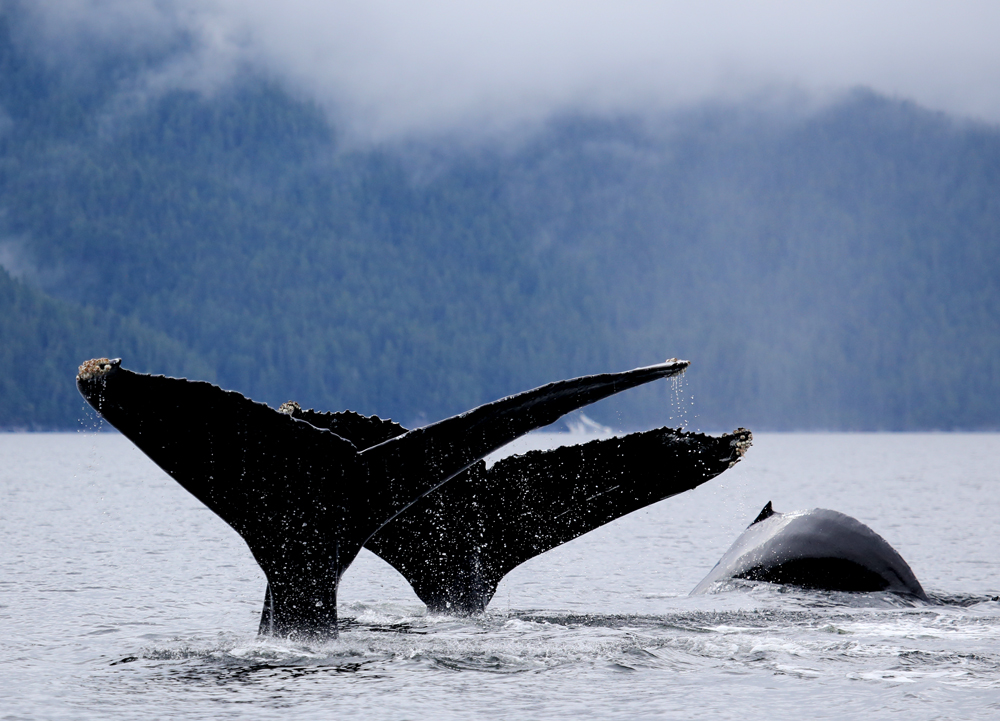
Yes, it would appear that, in my time here, I’ve been thoroughly whaled indeed.
Written By -Kim-Ly Thompson
Finding Yoda Part 4
Finding Yoda – Part 4
In 2002, Cetacea Lab’s Janie Wray and Hermann Meuter first encountered a very special humpback named Yoda. He’s returned to Caamano Sound every summer since. For over a decade, Cetacea Lab has recorded more and more humpbacks, like Yoda, returning to feed and sing their mysterious songs here. That’s why WWF is working hard with Cetacea Lab to protect this vital habitat. Food from B.C.’s north coast will sustain the whales long after they’ve departed for winter homes in Hawaii, Mexico or Japan. So where does Yoda spend his winter? Janie does some whale detective work and makes a surprising discovery along the way.
Written by Janie Wray, Director of Cetacea Lab
Every August, when Yoda makes his first rambunctious entrance to Whale Channel, I ask myself, “Where has this whale been all season?” The fact that Yoda arrives close to the same date each year tells me he’s on a schedule; his regular appearance on B.C.’s north coast is not some random event. Yoda will stay for the next month and has a definite reason for showing up when he does.

Rambunctious Yoda always makes a splash. © Forwhales.org
- Humpbacks spend part of every summer and fall filling up on food from these nutrient-rich waters. Late in November, many will head for warmer waters across the Pacific to mate and have their young. We believe Yoda shows up here to participate in social behaviours important to humpback culture – singing or mating rituals inquiet ocean waters. But where does Yoda go in the winter? And what can we learn from that?
Finding a whale in the Pacific Ocean – even one as distinctive as Yoda – is not an easy task. I began my search for his winter home by looking through catalogues of humpback whales documented in Hawaii, Mexico and Japan. Scientists identify humpbacks from ID photographs of their massive patterned tails called ‘flukes’. No whale tail is alike and, as you can tell from the photo below, Yoda’s all-white fluke is hard to miss. I searched through catalogues of photos hoping to spot this fluke – but no luck.
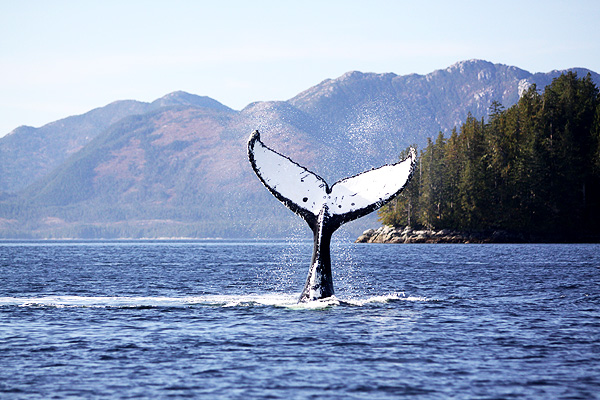
Yoda’s unique almost all-white fluke markings make him easy to spot. © Forwhales.org
More than a thousand photos later, I thought there must be an easier way. I seek help from a colleague I’d worked with at the SPLASH project in 2004. This was a three-year, international, cooperative effort by researchers to understand the population structure of humpback whales across the North Pacific. Every whale was given an ID according to the color of his or her tail: “X” whales have black flukes,“Y” whales have black-and-white flukes, and “Z” whales have white ones.
Searching the SPLASH database, I soon realized, would also take forever; there were thousands of whales to sort through! As my frustration reached a peak, my colleague sent good news – a website address where I could key in Yoda’s B.C. ID number and get a corresponding one for Hawaii or Alaska. I entered BCZ0136… and there was Yoda. He’d been spotted in Hawaii during the winter and Alaska in early summer.
But that’s not all. I was shocked to see the Hawaii database listed Yoda as a female! I’ve never been completely sure of the sex of this majestic whale but usually refer to Yoda as a male, after observing his behaviour for 12 years. Mistakes have been made on databases before, so unless Yoda shows up one year with a calf, I will tend to still identify him as a male. It’s not possible to identify the sex of a humpback from the surface without seeing its underbelly. And without a DNA sample or a calf by its side, we can’t tell for sure. But this discovery has added a new mystery to Yoda. I want to find out more!
Armed with Yoda’s Hawaiian ID number, I’m able to have a great conversation with my colleague at SPLASH that leads to some real information. Yes, Yoda does spend winters in Hawaii. He’s also been spotted in Alaska where he feeds for the first part of the summer. He heads our way in late August, stays well into October then returns to Alaska for another month before a long migration south across the Pacific to Hawaii.

Yoda’s vigorous acrobatics stir up the other humpbacks when he arrives. © Forwhales.org
It’s June – so we now know that Yoda will have likely passed our coastline, swimming north to Alaska. By late August, we’ll await his usual return – a vigorous display of acrobatics that stirs up the other humpbacks. We don’t know for sure why this area is so important to Yoda. But he’s back each year in time for the most spectacular social event of the season – the singing of male humpbacks in the deep fjords surrounding Whale Point.
These are some of the quietest ocean waters on B.C.’s coast, relatively free from man-made underwater noise and ideal for whale communication. One thing we do know, Yoda and other whales from across the Pacific depend on a quiet ocean home!
Learn more about Cetacea Lab’s work.
Learn more about WWF’s work on B.C.’s north coast.
Help protect the Great Bear Sea for now, and forever. Visit Greatbearsea.org and add your name.
Finding Yoda Part 3
Finding Yoda – Part 3
In a blog series this month from the Pacific Coast, whale researcher Janie Wray follows the story of Yoda, a charismatic humpback whale who literally makes waves wherever he goes. So far we’ve followed Yoda’s arrival to the rich summer feeding grounds of B.C.’s north coast. Today we find Yoda in the company of humpbacks that sing their mysterious songs in these quiet ocean waters. WWF is working here with Cetacea Lab on an exciting new hydrophone project – the first of its kind in Canada – to understand how noise from the increased shipping traffic in B.C. waters could affect this quiet habitat for whales.
Written by Janie Wray, Director of Cetacea Lab
It’s late August and I’m just finishing a whale survey in Squally Channel. Suddenly, I see a whale blow close to one of our hydrophones that is stationed 80 feet below water in the intertidal zone. It’s been an extremely long day on the water, I’m exhausted, but something pushes me to identify this one last whale. I’m soon happy I did. Calling my research partner Hermann by marine radio, I only need to ask once, “Guess who I just saw?”
“Yoda, of course,” Hermann replies.
The last week of every August, we expect the arrival of this energetic humpback whale in Caamano Sound. And once again, Yoda is right on schedule. As the days become shorter, the humpbacks transition to feeding in smaller groups and the males begin to compete for females. This is when we know Yoda will arrive.
Back at the lab, I’m taking off my survival suit when I hear a sound that, to this day, melts my soul. On the same date as Yoda’s arrival, the first humpback song of the year has begun. At first I‘m so overwhelmed by the beauty of this song, I almost forget to press record. I can already tell this song – carried collectively by all the males – is different from the one sung last year. These calls are long with a gentle, hollow ending that echoes through the underwater canyons of Squally Channel.
The humpback’s song plays a huge role during the breeding season. Only the males sing, and even though we still don’t fully understand its purpose, we know their song is a crucial component of their culture; it’s believed to be essential to finding a mate.
It’s one thing to observe whales on the water but the ability to listen to them at the same time truly completes the picture. Whales depend on sound much the same way we depend on sight. They’ve evolved in an underwater environment where there is very little light – taking advantage of the ability water has to transmit sounds extremely far and fast. Humpback whales, like many marine animals, depend on sound to find food, look for mates, navigate and engage in social behaviours such as singing.
When we first arrived on Gil Island to study whales, we installed a network of underwater hydrophones from Caamano Sound to Douglas Channel. Now with the support of WWF, we’re working on an exciting new hydrophone network that will take us a step closer to understanding this acoustic world of whales. By triangulating the position of these digital underwater “smart phones”, we’ll receive data that will allow us eventually to pinpoint the exact location of a vocalizing whale.
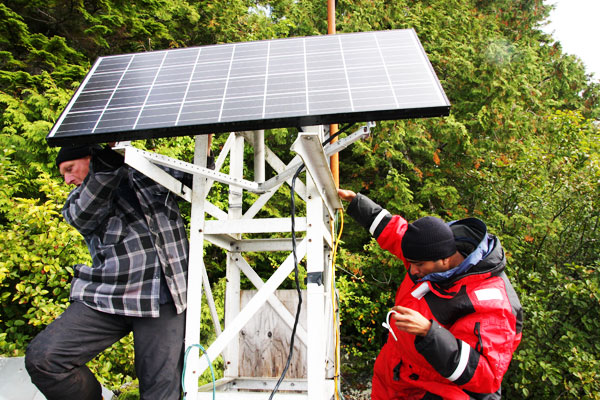
WWF’s Hussein Alidina helps Cetacea Lab’s Hermann Meuter set up a solar powered battery station to power a hydrophone. © Jo Anne Walton / WWF-Canada
Over time, we’ll be able to locate whale “hot spots” to determine where humpbacks gather to sing and feed. Looking ahead, I won’t be surprised to find out that, from season to season, these “hotspots” will be the same year after year. This gives us a better understanding of which areas are critical for habitat use and should be protected as low traffic quiet zone for whales.
This project will also help us understand how underwater noise from human activity – such as shipping – affects whales. Today these waters are among the quietest on B.C.’s coast; one of the majors reasons, I believe, humpback singing has increased here. When Hermann and I first set up Cetacea Lab in 2002, we recorded 40 to 50 hours per season of humpback whales singing. Now that number has reached well over 500 hundred hours of glorious song each year!
Tiny hydrophones are underwater listening devices that transmit whale sounds back to Cetacea Lab. © Hussein Alidina / WWF-Canada
Today, as I listen to the song arising from the depths of Squally Channel, it’s like going back in time. The only sound I hear in this quiet ocean is the masterpiece of song a humpback is creating.
Unfortunately, this may all change in the near future. Just as we’ve witnessed the remarkable return of humpback whales after near extinction from hunting, a new threat has come to the waters they call home. Massive tankers are proposed to transport oil and gas through these waters, bringing the threat of increased noise, ship strikes and spills. So today, as I sit and listen to this whale I imagine to be Yoda, I’m grateful for this soulful performance, yet saddened this magical place may not remain in the future as it is today.
Lets make sure that it does!!
Finding Yoda Part 2
Finding Yoda – Part 2
From Canada’s Pacific, whale researcher Janie Wray follows the travels of Yoda, a charismatic and well-known humpback that arrives every year in Caamano Sound on B.C.’s north coast. In Janie’s last blog post, Yoda announced his annual return to Whale Channel after a long journey from somewhere across the Pacific Ocean. Today, we find Yoda in the humpback feeding grounds where whales spend their summers filling up on food in the nutrient-rich north coast waters. This is an important feeding area for not just Pacific humpbacks but a range of other species as well and another reason why WWF is working with Cetacea Lab to help protect whale habitat for these recovering populations.
Written by Janie Wray, Director of Cetacea Lab
It’s 5 in the morning on a day in late August and my research partner Hermann Meuter and I are up early, sipping coffee, as we listen to the early feeding calls of humpback whales. The haunting sounds are broadcast from a network of hydrophones placed in strategic underwater positions in the coastal waters surrounding us.
This has become our favourite wake-up call of the season. The ocean here is rich with nutrients that provide enough food— including herring and small, shrimp-like animals called krill – to sustain massive amounts of humpback feeding, from first light until dusk, every day now from August through to November.
I packed supplies the night before as I’m determined to spend the entire day on the water to observe today’s feeding frenzy. As Hermann and I navigate our research boat south, the sun is peeking over the mountains, shining a golden path of sunlight on a calm sea. There’s no sign of Yoda but it’s not long before we spot a group of nine other humpback whales against the shoreline of Campania Island in Squally Channel. They’ve chosen this spot to engage in one of the most cooperative and spectacular feeding events on this planet – bubble net feeding.
Giant mouths of feeding humpbacks break the surface, ingesting krill and tiny forage fish.
© Forwhales.org
The massive humpbacks work as a team; each member has mastered its technique. One by one, they begin to dive. Huge flukes (whale tails) reach for the sky, before dipping smoothly below the surface. I lower the hydrophone overboard and soon we’re listening to distinct feeding calls. The calls climax and I wait for the group to surface. Within seconds, a circle of bubbles boils up. Next, the water explodes as giant, gaping mouths break the surface. Pectoral fins flap, grunts and deep blows sound, as each whale takes in a mouthful of fish. As they close their mouths, massive tongues will press out all the seawater through baleen plates that act like fuzzy brushes to strain out seawater and keep in food.
After a series of blows, the whales return to the depths. Surrounding a school of fish, the group collectively begin to blow bubbles through their blowholes. As they swim together in an upward spiral, the bubbles create a net, forcing the fish to the surface. Our hydrophone relays the sound of first one then another whale, vocalizing feeding calls. These calls helps force the fish into an even tighter ball so they can’t escape, providing the whales with even more food for their effort.
On the fringe of this bubble net feeding, I notice sea lions, Dall’s porpoises and a diversity of sea birds waiting to join the fray. I realize how vital a role humpback whales play in this ecosystem. They bring a food source to the surface that would not be readily available to these opportunistic spectators.
Humpbacks don’t eat during the winter months, so the feeding they do in the Great Bear Sea coastal waters will sustain them the entire year. The ocean here is also naturally quiet, allowing them to communicate with one another to coordinate this group feeding activity.
Through binoculars, I notice another humpback whale quickly making its way towards the group, most likely attracted by the feeding calls. When it comes within 100 meters, everything suddenly changes. The surfacing whales begin a series of urgent, tonal blows, tail slaps and lobbing of heads against the water. They’re obviously upset by the presence of this newcomer.
Who is this whale that can cause so much commotion? The whale begins to fluke, diving below the surface, its tail standing at attention in the air. I aim my camera in its direction, hoping to get an ID. The familiar, all-white tail holds position above the sea and I’m shocked – it’s Yoda! Suddenly, very close to the boat, Yoda’s massive body effortlessly leaps into the air, then slams down hard, the sound echoing across the water as he breaches again and again.
The group dynamics between humpback whales fascinate me. Why was Yoda not welcome? Is there a history here we are unaware of? It will take decades of research to understand this type of personal behavior and relationships between humpbacks. I sense that Yoda is a dominant whale, whether male or female, which may have provoked a reaction from certain whales in this group.
Whatever the reason, Yoda slowly begins to leave the group after an amazing acrobatic display. I cannot help but hope that he, or she, finds companionship and will stay for the rest of the season.
Finding Yoda
Finding Yoda – Part 1
In 1996, citizen scientists Janie Wray and Hermann Meuter came together through their shared passion to protect and research whales on Canada’s Pacific Coast. Heading north to B.C.’s Great Bear region, they gained permission from the Gitga’at First Nations to build Cetacea Lab, a hydrophone research station on remote Gil Island. Since 2012, WWF has partnered with Cetacea Lab to support their work in monitoring and protecting whales. In the first of a 6-part blog series, Janie introduces us to Yoda, a charismatic humpback whale. ‘Finding Yoda’ follows the seasonal migration of humpbacks, showing how vitally important B.C.’s north coast waters are for humpback populations across the Pacific Basin.
Written by Janie Wray, Director of Cetacea Lab
- Cetacea Lab’s remote location on B.C.’s north coast, Hermann and I have witnessed the remarkable return of the humpback whale to Canadian waters over the last decade. Years of hunting had brought these gentle giants to the edge of extinction. In our first season at Whale Point, we counted only 42 whales in our area. Twelve years later, we’ve seen that grow to 318 humpbacks returning here each year.
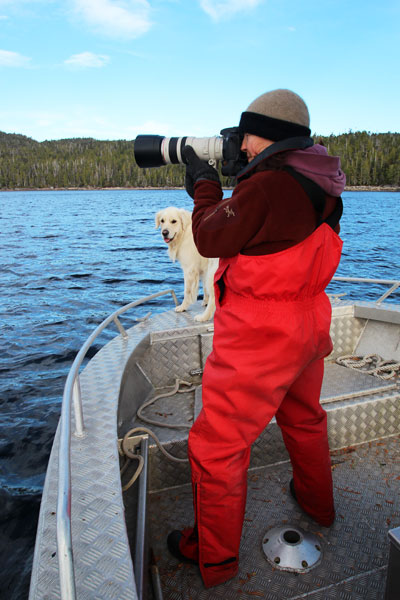
Janie Wray and dog Cohen looking for Yoda in the coastal waters of the Great Bear Sea. © forwhales.org
We believe there are two important reasons for this increase of humpback populations in our area – access to plentiful food and quiet ocean waters ideal for whales to communicate in. The coastal cold ocean seas here are packed with nutrients and tiny forage fish that humpback whales consume, not with teeth, but through a baleen filter feeding system in their enormous mouths. And since allwhales are acoustic creatures, these quiet waters are an ideal haven for humpbacks that use sound to look for food, find mates, navigate and engage in social behaviours.
On the water and from the vantage point of our lab at Whale Point, Hermann and I noticed that we were seeing the same humpback individuals from year to year. We also began to realize that a large community of resident whales were returning to our area every season. The more time we spent with certain individuals, the more we recognized their particular personalities.
One September day, I was out in the research boat, a hydrophone suspended overboard to listen underwater to whales. Suddenly, I heard a huge explosion, then another. In the distance I could see massive amounts of water shooting up from the sea, but from what, I wasn’t sure. Traveling closer, I realized it was a humpback whale I’d never seen before, lifting a beautiful white tail high into the air, and slamming it down into the calm sea, displaying tail slap after tail slap. The whale we would come to know as Yoda then rolled onto its back, still managing to lift this massive tail up and out of the water and slam it back against the surface.
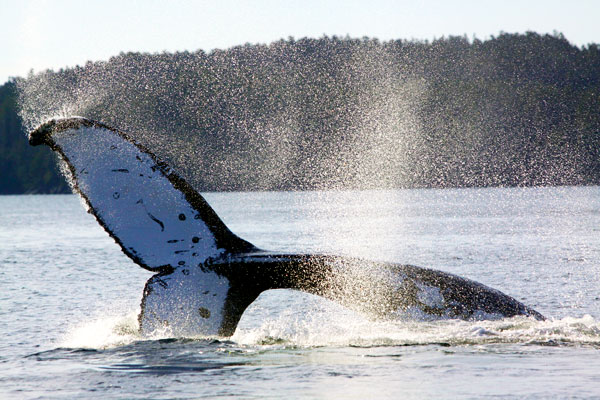
Yoda’s distinct white fluke markings and acrobatic behaviour. © Forwhales.org
I’d never seen a whale maneuver its tail in this manner. The pure strength and stamina it took to keep this going was truly amazing. One can speculate as to the real intention of this acrobatic display but that day it seemed this was Yoda’s announcement to the whale world – I have arrived!
Since this first arrival, Yoda has returned to Whale Channel every year within two or three days of the exact same day in late August every year – a remarkable feat given where this lively cetacean started from. Yoda and other humpbacks spend their winters in southern waters off Hawaii, Mexico or Japan. We don’t know yet where Yoda heads to when he leaves Caamano Sound in late November, but we do know that B.C.’s quiet north coast waters provide critical refuge for Yoda and other humpbacks during the summer and fall.
During the winter months, the pregnant females give birth to their calves, and males compete for the attention of females. They don’t eat during this entire period. Instead, in early spring, they head north to their feeding grounds in B.C. and Alaska, an amazing 3,000-plus mile migration across the Pacific Ocean.
Imagine that a mother, who has just given birth and is nursing a calf, now needs to swim 3000 miles to find food. Young juveniles and even last year’s calves, no longer with their mother, must make this incredible ocean journey north. In the spring, all humpbacks will leave the south in pursuit of food. It’s a journey that can take up to six weeks and often, when the whales first arrive, we notice the fat they’ve lost over the winter, especially the new mothers.
By the end of June, humpback blows–great heart-shaped puffs of vapour–are a constant sight from our window overlooking Taylor Bight. They’re accompanied by long feeding calls heard over our network of underwater microphones called hydrophones.

Whale dog Neekas watches as a humpback ‘flukes’ off the bow. © Linda Nowlan / WWF-Canada
At Cetacea Lab, Hermann and I, our summer interns, and even our dogs Neekas and Cohen follow the humpbacks’ return day and night. Through speakers mounted in our lab, sleeping quarters, kitchen and even the trees, we listen to the natural sounds of a quiet ocean. The grunts and chirps of fish are followed by long moments of complete silence, then an ancient and diverse sound fills the space – the haunting call of a humpback whale.
Change Begins Today
On the Eve of Winter Solstice I sat and looked out the window at a wild sea. I watched, as one wave would follow another. So evenly spaced, flowing so effortlessly, each wave making way for the other. I tried to imagine an oil tanker, here, and something broke, shattered to the floor. I bent down and began to pick up the pieces, one at a time until they were all in my hand. I stood and once again looked out that window to the sea. I knew something dramatic within had just opened. I was ready to stand up and be part of a movement that is ready for a change.
I doubt anyone who really understands what is happening on our planet is at all surprised to hear that the JRP has approved the Northern Gateway Project; with a whole 209 conditions. That is like saying to someone – ok – you can commit a crime but there are conditions in regards to how you play that out. THEN it is ok. We would have been stunned if they had said no – that would have meant that they were actually listening to the 1000s of people, who wrote, or took the time to sit in front of the panel and speak from their hearts, explaining what this province actually means to them. First Nation leaders and elders spoke and they were thanked with a smile. But in truth no one was really listening.
We are at the moment of choice. Our history will be marked on this day. A realization has taken place. We live in one of the most beautiful places on earth and it needs our voice. If you do not think you can affect change – you are wrong. You can be a great agent of change. You can stand for something so meaningful by just getting involved. We can support those that take action. We can protest. We can appeal to government. Let's face it - we are the government. For them, it is all about pleasing the interests of big corporations and they are willing to go to any measure to do so. It is about the money and environment is their personal scapegoat. It is time for us to remember that we are the keepers of this money trail and can actually decide which way it should go. This is our boat and not their sea.
This planet knows when enough is enough. Something needs to be given back. We can treat our home as only a resource – or we can choose a compromise between our needs and those of the planet.
We have given them the chance to speak and make decisions based on their needs. Now it is our turn. So here we stand in solidarity with the First Nations where the Great Bear Rainforest meets the Great Whale Sea and say, “No tanker shall pass”.
Today we celebrate the return of the light, the sun, after the longest night of the year. For many cultures and for thousands of years this was the start of new beginning. How appropriate for so many of us today. Lets get started!
The Heart of the Great Bear Rainforest
This Blog has been written by Amy Huva who spent a glorious week with us here at Whale Point with her mother Denise and friend Caroline.
The Heart of the Great Bear Rainforest – Written By : Amy Huva
I love whales – especially killer whales. As a 10yr old, I spent all my pocket money on a necklace with a killer whale on it that I wore constantly. However, most of the time, the killer whales don't love me back. I'm famously unlucky with whale watching trips and dolphin watching trips – you name it, I've sat on a boat for hours and seen nothing.
So I was trying not to have very high hopes when I came out to visit Whale Point this week. I focused on seeing 1,000 year old trees, on experiencing the Great Bear Rainforest, seeing the salmon run, and maybe some whales in the distance.
So far, we have already been lucky on this trip – as we were travelling from Hartley Bay to Gil Island with Hermann on Monday, he spotted a Fin whale and a Humpback whale from a distance. I got a photo of the Humpback whale's tail with a long zoom on my camera and was pleased.
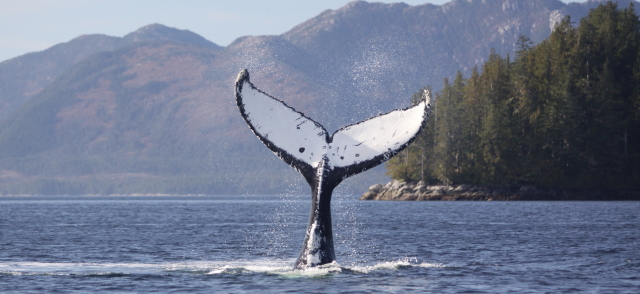
I hoped it wasn't going to be too blurry when I got home and put it on my computer, and was excited because it was the first time I'd ever seen a Humpback whale in real life.
This morning, our first full day on the island, we went down after breakfast to the lab to watch a group of Humpback whales feeding in the distance between Princess Royal Island and Ashdown Island. If we looked through binoculars, we could just see that there was a mother and a calf in the group of about 3 or 4 Humpback whales.
Later, after getting some coffee in the house, we were setting out towards the creek to see where the salmon run when someone made a comment that they thought the mother and calf Humpback whales were swimming towards Whale Point. No sooner had the comment been made, we heard a crash out on the water and Hermann shouted 'oh wow! The mother just breached!'
We rushed further down the rocky beach towards the water and I suddenly saw the Humpback whale jump up and out of the water, and land with a huge crash on her back.
It seemed to be a mother-daughter breaching class. The mother whale would jump up and crash down and the calf would copy her. It was the most amazing sight – seeing these huge mammals put on such a display and hearing the seriously loud boom as they landed on the water, or the clap as they slammed their fins down playing on the water.
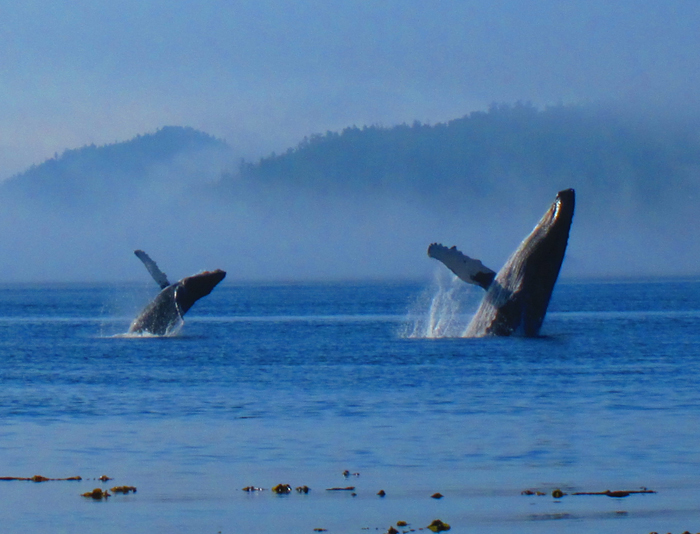
They were playing around – rolling over in the water and waving their fins in the air, slapping their tails down, leaping out of the water, with the calf following and copying her mother the whole time as they moved across the bay we were standing in.
It was so phenomenal – watching something from the shore that I've only ever seen in a documentary, experiencing it and feeling the power and pure strength it must take to get such a huge body out of the water like that. Seeing the whales smack down on the surface and then hearing the slightly delayed boom as the speed of sound caught up to where we were standing.
It's only our second day here, but so far it's already been magical experiencing the heart of the Great Bear Rainforest in all it's glory.
Her story continues in the Vancouver Observer - LInk Below
http://www.vancouverobserver.com/blogs/earthmatters/whale-watching-heart-great-bear-rainforest
Humpbacks Bubble Net feed- video
This Journel Enrty was written by a young girl who was staying with us at Whale Point. Her name is Maddie Picard and this is her experience on the water with an amazing group of humpback whales bubble net feeding. Please watch the vidoe below as well - it is truly inspirational!!
On August 21st 2013 we spotted a group of 5 humpback whales by Fawcett Point, on Gil Island. We went out on our boat the Elemiah to see the whales. Once we arrived we realized the whales were bubble net feeding. There were 4 juveniles and one adult named Drop. Three of the whales were named BCX whales because the backsides of their tails are black. There were two whales that had completely white tails. They are named BCZ whales. Cohen, our golden retriever was on the bow and as usual was making some very funny noises. After a lot of feeding the whales split into 2 groups. The BCZ whales went together and the BCX whales escorted Drop as he had decided to leave and look for the large bubble net feeding group, which he is a part of. Then the 2 BCX whales came back and all the juveniles joined up again. After watching the whales for a bit longer we decided to head back as it was really beginning to rain hard. Here is a video of the whales.
Orcas of the Great Bear Sea
Written by Sophie Scotter
It can be so easy to become trapped in life’s little tide-pools – many of us will embrace it, like the humble sea anemone, whilst others, myself included, will worry that little bit more about the return of each flood tide, perhaps more like a rock sculpin, flitting back and forth between excitement and trepidation. There are days however, when life gives you that little shake, and you realize that as long as the tides are indeed still turning and the sun is still rising, everything will always turn out just fine. Let me tell you why today was one of those days.
Hermann, Katie, Neekas and I were out on the water by 7am, after hearing both G and R clan calls on the Squally Channel hydrophone. This wide passage is favored by Orca who cruise the shorelines of Campania and Gil Island, reaffirming bonds, fishing, playing and seemingly very much embracing the to-ing and fro-ing of day to day life in these chilly waters. When we first located the 3 groups of whales, the sun had barely crept up in the East and rays of light plunged each dorsal fin into a beautiful silhouette as it rose and fell through the water, the vapor from blows raining down on these majestic ‘blackfish’ (a native term) like an angelic aura.
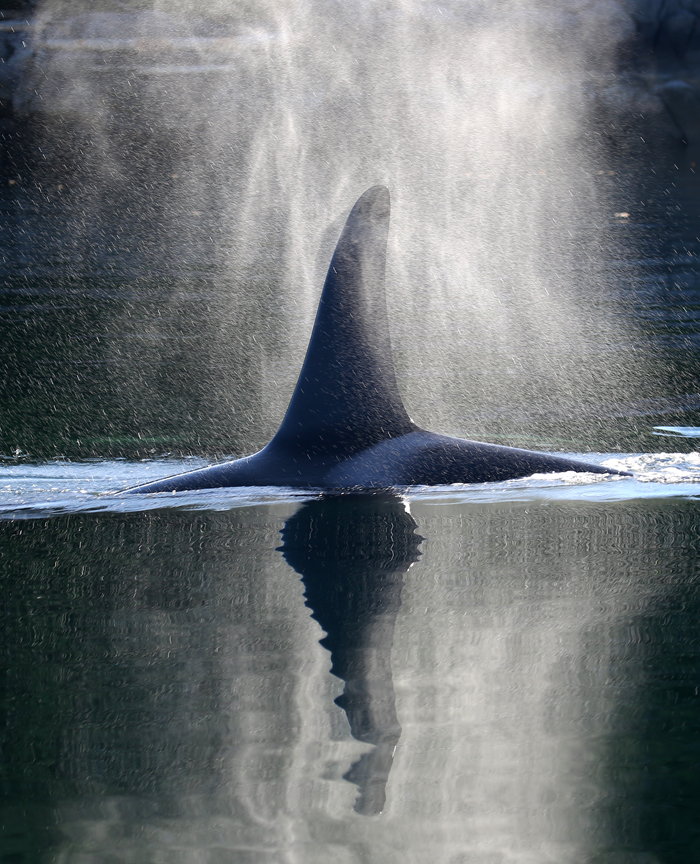
They seemed hardly to mind as we travelled alongside them and the sun soon became high enough to follow them as they swam slowly under the water, staring up at us with inquisitive eyes and displaying their ‘jigsaw piece’ white undersides, a stark contrast against the dark dawn water. Leaving the shoreline for a moment to navigate the protruding rocks, the whales approached the boat carefully and the following moment was truly one to behold. As the female dove, she turned on her side to cast us a glance as she swam beneath the boat, joining a large male on the port side as he too dove for a brief moment to show us his enormous size and beautiful coloration. To have such a moment of silent, emotional exchange with Mother Nature is extremely clarifying and for a second everything else, everything I could possibly think of, seemed totally insignificant as tears began to stream down my face. I was not alone, in that moment we were all on the same page. Each of us understood perfectly why we share an all-consuming passion for whales and why protecting them has become a part of each and every one of our lives in all kinds of wonderful ways.
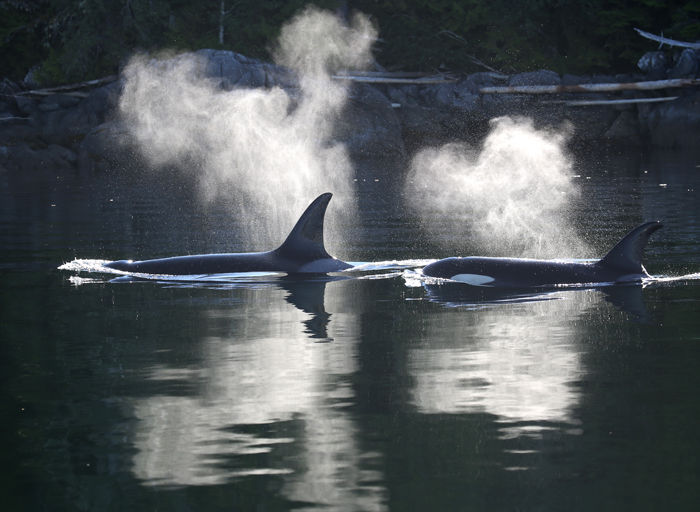
We stayed with the groups as they merged and watched in awe as they hung gently at the surface, with eyes in every direction and juveniles running amok amidst the resting adults. They would roll onto their backs with pectoral fins and flukes smashing down onto the surface of the water, the sound taking seconds to reach us as they kept their distance and retained tight formation. Occasionally the whales would motion above the water head first in a ‘spy-hop’ and without creating so much as a ripple on the surface they would take in their surroundings before sinking gracefully back underwater. The whales spent over and hour deliberating their next change of direction, during which time we were greeted with the tonal blows of several large humpbacks that were cruising at the surface and could be heard for miles around. The abundance of whales created for a puzzling morning of not knowing where to look next – but I wouldn’t have it any other way. As we headed over to the coast of Campania, the I15 matriline signed out with an excited call that could be heard through the hull of the boat, and then they were gone.
Today the wilderness came knocking at my door and as far as I‘m concerned, as long as the dorsals are still rising and the whales are still singing, everything will indeed be just fine.

 Blog
Blog